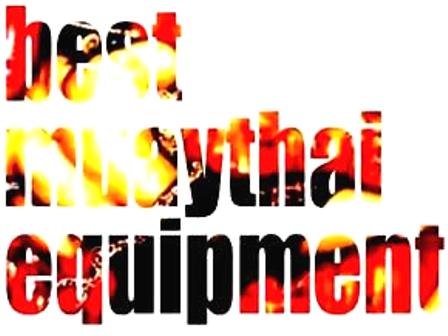Muay Thai Basic Techniques
punches, elbows, knees, kicks…all nasty ones!
Introduction
Muaythai techniques were known as the “art of eight limbs” as there are eight natural weapons to fight with: fists, elbows, knees and feet. The most peculiar muaythai techniques, which also differentiate Thai boxing from Chinese and Japanese martial arts, are related to the use of elbows and knees to ultimately destroy the opponent. The risk of injuries from such blows is quite high, therefore in many international tournaments elbows strikes are banned, penalizing Thai fighters when matched against foreign champions. Even in Thailand, some beautiful and vicious elbow/knees combinations are rarely used, or forbidden, as muay thai itself is evolving into a less pure form of traditional Thai boxing.
Traditionally, the art of pahuyut was divided into two main categories: muay lak and muay kiew. The former me is on the verge of extinction. It was known by master boxers decades ago but you won’t see it anymore in a ring. The emphasis was on lethal combinations of attack and counter-attack, fighting at very close range and in a straight line. The fights were more static, with less room to move around so the strategy was based on speed and power. Less blows were exchanged, as both opponents had to be extremely cautious in defending themselves effectively and to be able to strike back counter-attacking. Muay kiew (stylish boxing) is, on the contrary, the spectacular, standardized muaythai we know, full of tricks, faked movements and classic techniques. muaythai techniques
Yang Saam Khum – (three-steps walk) techniques
The peculiar, ondulating walk so typical of every Thai fighter is perhaps the most important technique to master before learning anything else. It is the basis of all footwork and the first thing to be taught a beginner nak muay. The graceful side of it is displayed during the wai kruu dance, while the boxers move around the ring gracefully, following an ancient rite but at the same time dangerously ready to strike like a cobra. This double-side of a muaythai fighters, the gentleness and the brutality, seems a common trait amongst Siamese soldiers or martial artists since centuries ago. Every violent matter, like a public beheading or a krabi krabong duel, was always preceded by graceful Buddhist rituals, resembling an effeminate dance and accompanied by perfumed lotus flowers, incense sticks and an hypnotic music. And followed by an unexpected flow of the most shocking violence. In brief, the yang saam khum is a way to move around the opponent without showing the direction of movement while keeping a perfect balance. This also is the “platform” for all mae mai (see next pages) techniques. Noticeably, the yang saam khum follows the high-pitching rythms of the Sarama music played throughout the fight. muaythai techniques
Kicks
There are three levels of kick: low (targets: calf, tigh, back of the knee), medium (targets: ribs and torso) and high (targets: chin, temple, neck). The basic ones are called teh phaen than (basic kicks). They are: teh pa mak (front kick), nep (pecking kick), teh tat (sweeping kick), teh pap nok (kick outside the knee joint), chorakee fat hang (reverse back kick). In muay thai, kicks are delivered with a full swing of the hips and trunk to accentuate the damage. Also is the shin, not the foot, which hits the target. This peculiarity of Thai boxing is highly risky if the kick is not successful: not a few fighters broke a shin bone hitting the tip of the opponent’s raised knee. muaythai techniques
See some good muay thai kicks below:
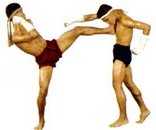
teh jooh
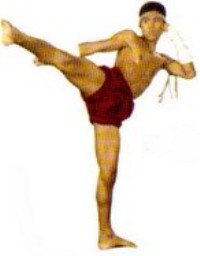
teh chiang
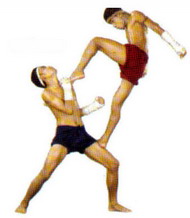
teh hiap
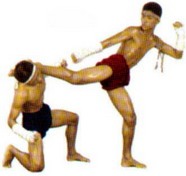
teh koht
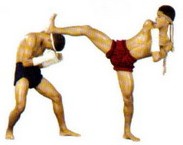
teh ko hok
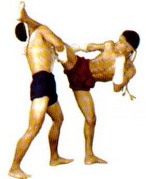
teh klap lang
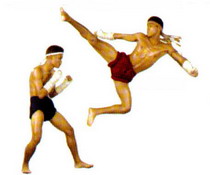
teh kradoht
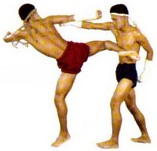
teh krheng keng krheng kao

teh rit
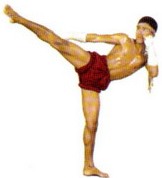
teh dtat bon
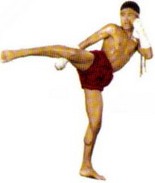
teh dtat klang
Elbows
The elbow is meant to cut the opponent skin and draw blood. It is used as a sharp razor, as the tip of the elbow, not the all arm, should hit the target. Therefore the aim is not at hitting bruntly, but to quickly scratch the target, like a sheet of paper going swiftly through the flesh. Unfortunately, spectacular elbows KO’s are nowadays quire rare. There are eight kinds of elbow strikes: sok ti (striking elbow), sok tat (cutting elbow), sok hut (levering elbow), sok chieng (diagonal elbow), sok sap (choping elbow), sok tong (pull down elbow), sok kuu (double embow), sok klap (reverse elbow). muaythai techniques
See some good elbows hits below (some are muay boran tricks):
muay thai techniques
sok chiang
muay thai elbow techniques
sok chiang tee khn
muay thai elbow techniques
sok kian
muaythai elbows techniques
sok klap
muay thai elbow techniques
sok klap tee khn
muay thai elbows techniques
sok kratung
muay thai elbows techniques
sok klap tee long
muaythai elbows techniques
sok long
muay thai techniques
sok long kuu
muay thai techniques
sok ngak
muaythai techniques
sok plamong tee nguak
muaythai techniques
sok pung
muaythai techniques
sok dtat
muaythai techniques
sok thuan
Punches
In muaythai the punches are no different from traditional boxing, perhaps with the exception that the nak muay must learn to twist the wrist a moment before the impact. This trick helps penetrating the opponent’s guards and increases the power of the punch, which must be retracted immediatley to avoid a plethora of counter-attacking techniques. Punches anyway are not used to knock down an oppponent, but barely to distract him whilst preparing a knee/kicks combination to attack. The most used kinds of punches are the jab, the straight punch, the swing and the hook.
Knees
Knees are perhaps the most important weapon in muaythai and definitely the most used throughout any fight. Together with elbows, knees are considered lethal weapons and sufficient to demolish an opponent. The correct way to throw the knee is to thrust it straight and upwards, otherwise it will be ineffective and dangerous. The tip of the foot must be always pointing upwards, in order to be turned into pecking kicks (nep) if necessary. Nowadays you’ll see plenty of knees action directed at the flanks or the abdomen, especially when fighters cling at each other necks trying to pull down, hoping for a devastating knee in the opponent’s face. This seem the most common feature in muaythai matches now. .
See some good knee strikes below:
muay thai techniques
kao hiap
muay thai techniques
kao ion
muay thai techniques
kao kuu
muay thai techniques
kao laa
muay thai techniques
kao loi
muay thai knee techiques
kao nehp
muay thai techniques
kao noi
muaythai techniques
kao dtat
muay thai techniques
kao trong
muay thai techniques
kao yo
muay thai techniques
kao hohn
muaythai techniques
ka koht
muay thai techniques
kao chiang
muay thai techniques
kao kohng
The nep
The nep is a nasty push kick used for defense, attack and/or to keep the opponent at distance. The target is usually the abdomen or the sternum. To be effectivem the nep has to be delivered with the tip of the toes up. Whilst it’s not a lethal kick and it’s not expected to create much damage, the nep is used very often to disturb the opponent concentration or to seek the right range or angle before striking.
Mae Mai
These are the “mother techniques” of muay thai involving fists, feet, knees, and elbows, for attacking and defending. Originally such techniques were not standardized as every kruu taught its own style. Nowadays some have disappeared, some have been replaced by more effective ones, some are banned. Therefore, the actual “standard” muaythai techniques are grouped in fifteen mae mai, which are learnt first, followed by another fifteeen luk mai (more advanced ones). Then the nak muay learn how to combine all techniques in order to implement powerful combinations of all tricks (cherng muay). All techniques for attacking and counter-attacking are called khon (strategies).
